Submarines with their hands (13 photos)
 Bashny.Net
Bashny.Net
There is a website devoted to the works of William Wardrop (William Wardrop), which is called - Stream Noir.
William collects paper models on their own, in their technology.
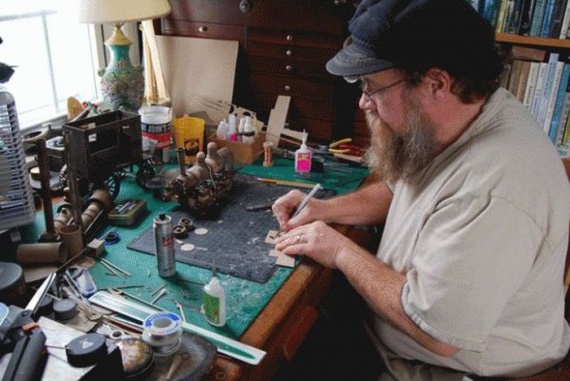
After decades of extensive research into the history, concepts of military art and classical literature, he applied his knowledge in modeling to create a unique three-dimensional example of the many types of innovative and eccentric vehicles 18, 19 and early 20th centuries.
This exhibition is a vivid example of how the vehicles of the Victorian era, based on steam technology, catching up science fiction to create the technical marvels that changed civilization and pushed us into the modern era.
Jules Verne's Nautilus (The Jules Verne Nautilus)
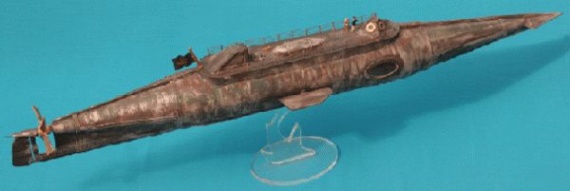
This model was developed based on Jules Verne's descriptions and original illustrations for his novel 1870 - "Twenty Thousand Leagues Under the Sea." Although this model is less elegant than the Nautilus who invented Hollywood, it is collected in accordance with the first real submarines.
In this image you can see the professor Aronneksa, arguing with Captain Nemo on the fate of mankind.
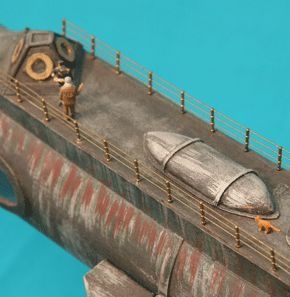
Gustav Zed (Gustave Zede)

Gustav Zed was a big step forward in the development of French submarines, but not very successful. She was carrying two torpedoes discharged on the rings, making them vulnerable, while the submarine was in the dock. She also held the bad depth, and eventually took three sets of seaplanes to help design this error. Zed Gustav was 48, 5 m. (159 ft) long, 3 m. (10 feet) in diameter and had an engine capacity of 208 horsepower.
Pioneer (The Pioneer)
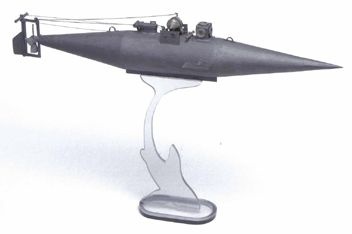
Built in the Mobile bay, CLHunley (persons - approx. Per.) Before the construction of CSS Hunley (submarine - approx. Per.), The vessel was a prototype and was never used. His weapon was a mine that produced behind the submarine and ran on the cable until it finds its target on collision with which both exploded. The main problem of this system is the possibility of winding the cable on the screw.
Pioneer was captured by Union Army in 1863 and exhibited in the courtyard of the Washington Navy Department, until it was sold for scrap in 1867.
American diver (The American Diver)
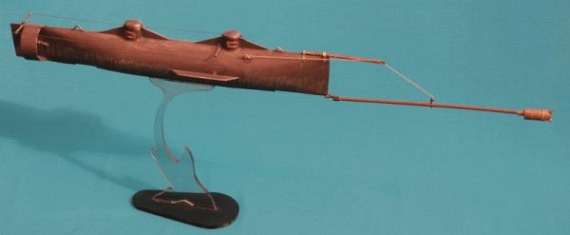
Built C.L. Hunley after Pioneer. American diver or Pioneer 2, as it is sometimes called, sank in the Mobile bay, while being towed to start the attack on the Navy Union. The three-man crew was extremely small, and the submarine was not able to fight the tide. Description of the submarine appeared in newspapers in France, Jules Verne might have seen this description and included many unique attributes of the American diver in "Nautilus", such as double cabin.
Nautilus Harper Course (The Harper Golf Nautilus)

Designed for Disney "20,000 Leagues Under the Sea", the original model was created Harper golf to create a Victorian style, as individual elements make it more like the sea monsters. Although hydrodynamic tests have proved that the submarine will be a reliable, full-size working model was never created.
The giant squid attacking the model Naytilusa more than a meter (three feet) long and was made entirely of brushes for cleaning pipes Laura Butler.
Alligator (version Naval Institute Press?) (The Alligator (Naval Institute Press Version))
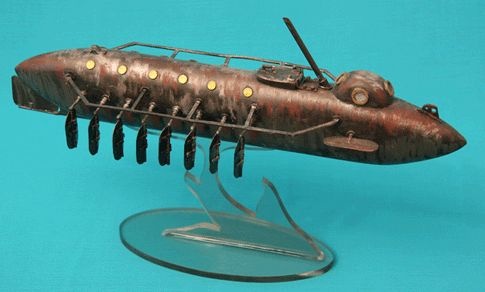
This is - a great example of why you should always find many references as you can find before you jump in and build a model. Alligator shown here - that's what I saw in the book "American submarine Until 1945" from the Institute of Naval Press. I said, "Cool!" And went to work. It took 26 hours to build and paint a model. I was pleased with the result and recorded another historic submarine at his own expense for my collection. However, two days later, after I put the model on the rack, I read on a news site that the original plans Brutus de Villeroya were found in Paris, France. It was enough a glance to understand that my model does not look as original designs. It turns out that the scheme NIP'a - guesswork and never tested!
The Garrett Nordenfeldt 1886

After the "success» Littler Garrett George William's first submarine in the steam engine Resurgam, in 1879 he was commissioned by the Turkish government to build two submarines in 1886. They were built and shipped unassembled to Constantinople, where they were collected. First it sank almost immediately after the start, and, oddly enough, for submarines because more and could not find the crew. They stood in dry dock until 1914, when they were blown up by the German army, in order to avoid threats to public safety.
Seal (The Seal)
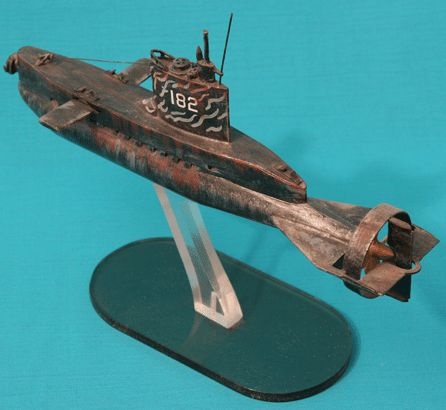
Originally Launched at the shipyard in Virginia in 1911 as a seal. This submarine was renamed in the G-1, when she was assigned to the USN in 1912. After a long journey as a test and training ship, she was decommissioned in 1920 and was later used to test the depth charges in 1921.
The Welman

Welman - WWII submarine, controlled by two people, driven by a gasoline engine, which lacked proper ventilation and caused many deaths due to carbon monoxide poisoning. Torpedoes were too small to be a real threat of military ships of that era, and had a limited range. Submarine different double door and a total design that had a significant impact on the design of submarines of the period.
Dupuy de Lome
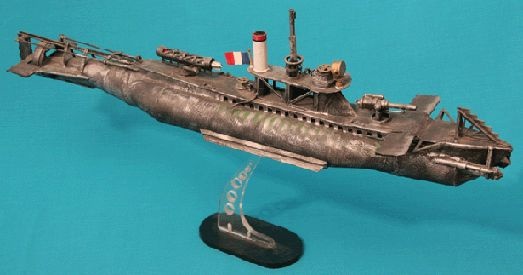
Named after the famous architect armored warships, the French submarine was launched in 1915 and sent for scrap in 1935.
Ictineo II (Translated from the Greek fishing boat)

In 1864, in the Barcelona harbor, Monterayol Narcissus (Narcis Monturiol) began Ictineo II: the first real submarine in the world. It was more than 17 meters in length, a displacement of 72 tons and had a working depth up to 30 meters. What made this submarine so unusual, it was a steam engine on the basis of the chemical. The engine was needed fuel rods, very similar to the uranium rods in the reactor, but to use a chemical reaction to heat water in the boiler, at the same time, the reaction was pure oxygen for the team! The body was made of olive wood, to reduce the cost of the prototype, but was planned and all-metal boat - Ictineo III. The time spent under water without oxygen deficiency, was 8 hours! The only limitation was the number of fuel rods. Ictineo III could push the technology of submarines to a new level, but funding ran out Monterayola and his submarine was broken up and sold for scrap.
Source: p-i-f.livejournal.com
William collects paper models on their own, in their technology.

After decades of extensive research into the history, concepts of military art and classical literature, he applied his knowledge in modeling to create a unique three-dimensional example of the many types of innovative and eccentric vehicles 18, 19 and early 20th centuries.
This exhibition is a vivid example of how the vehicles of the Victorian era, based on steam technology, catching up science fiction to create the technical marvels that changed civilization and pushed us into the modern era.
Jules Verne's Nautilus (The Jules Verne Nautilus)

This model was developed based on Jules Verne's descriptions and original illustrations for his novel 1870 - "Twenty Thousand Leagues Under the Sea." Although this model is less elegant than the Nautilus who invented Hollywood, it is collected in accordance with the first real submarines.
In this image you can see the professor Aronneksa, arguing with Captain Nemo on the fate of mankind.

Gustav Zed (Gustave Zede)

Gustav Zed was a big step forward in the development of French submarines, but not very successful. She was carrying two torpedoes discharged on the rings, making them vulnerable, while the submarine was in the dock. She also held the bad depth, and eventually took three sets of seaplanes to help design this error. Zed Gustav was 48, 5 m. (159 ft) long, 3 m. (10 feet) in diameter and had an engine capacity of 208 horsepower.
Pioneer (The Pioneer)

Built in the Mobile bay, CLHunley (persons - approx. Per.) Before the construction of CSS Hunley (submarine - approx. Per.), The vessel was a prototype and was never used. His weapon was a mine that produced behind the submarine and ran on the cable until it finds its target on collision with which both exploded. The main problem of this system is the possibility of winding the cable on the screw.
Pioneer was captured by Union Army in 1863 and exhibited in the courtyard of the Washington Navy Department, until it was sold for scrap in 1867.
American diver (The American Diver)

Built C.L. Hunley after Pioneer. American diver or Pioneer 2, as it is sometimes called, sank in the Mobile bay, while being towed to start the attack on the Navy Union. The three-man crew was extremely small, and the submarine was not able to fight the tide. Description of the submarine appeared in newspapers in France, Jules Verne might have seen this description and included many unique attributes of the American diver in "Nautilus", such as double cabin.
Nautilus Harper Course (The Harper Golf Nautilus)

Designed for Disney "20,000 Leagues Under the Sea", the original model was created Harper golf to create a Victorian style, as individual elements make it more like the sea monsters. Although hydrodynamic tests have proved that the submarine will be a reliable, full-size working model was never created.
The giant squid attacking the model Naytilusa more than a meter (three feet) long and was made entirely of brushes for cleaning pipes Laura Butler.
Alligator (version Naval Institute Press?) (The Alligator (Naval Institute Press Version))

This is - a great example of why you should always find many references as you can find before you jump in and build a model. Alligator shown here - that's what I saw in the book "American submarine Until 1945" from the Institute of Naval Press. I said, "Cool!" And went to work. It took 26 hours to build and paint a model. I was pleased with the result and recorded another historic submarine at his own expense for my collection. However, two days later, after I put the model on the rack, I read on a news site that the original plans Brutus de Villeroya were found in Paris, France. It was enough a glance to understand that my model does not look as original designs. It turns out that the scheme NIP'a - guesswork and never tested!
The Garrett Nordenfeldt 1886

After the "success» Littler Garrett George William's first submarine in the steam engine Resurgam, in 1879 he was commissioned by the Turkish government to build two submarines in 1886. They were built and shipped unassembled to Constantinople, where they were collected. First it sank almost immediately after the start, and, oddly enough, for submarines because more and could not find the crew. They stood in dry dock until 1914, when they were blown up by the German army, in order to avoid threats to public safety.
Seal (The Seal)

Originally Launched at the shipyard in Virginia in 1911 as a seal. This submarine was renamed in the G-1, when she was assigned to the USN in 1912. After a long journey as a test and training ship, she was decommissioned in 1920 and was later used to test the depth charges in 1921.
The Welman

Welman - WWII submarine, controlled by two people, driven by a gasoline engine, which lacked proper ventilation and caused many deaths due to carbon monoxide poisoning. Torpedoes were too small to be a real threat of military ships of that era, and had a limited range. Submarine different double door and a total design that had a significant impact on the design of submarines of the period.
Dupuy de Lome

Named after the famous architect armored warships, the French submarine was launched in 1915 and sent for scrap in 1935.
Ictineo II (Translated from the Greek fishing boat)

In 1864, in the Barcelona harbor, Monterayol Narcissus (Narcis Monturiol) began Ictineo II: the first real submarine in the world. It was more than 17 meters in length, a displacement of 72 tons and had a working depth up to 30 meters. What made this submarine so unusual, it was a steam engine on the basis of the chemical. The engine was needed fuel rods, very similar to the uranium rods in the reactor, but to use a chemical reaction to heat water in the boiler, at the same time, the reaction was pure oxygen for the team! The body was made of olive wood, to reduce the cost of the prototype, but was planned and all-metal boat - Ictineo III. The time spent under water without oxygen deficiency, was 8 hours! The only limitation was the number of fuel rods. Ictineo III could push the technology of submarines to a new level, but funding ran out Monterayola and his submarine was broken up and sold for scrap.
Source: p-i-f.livejournal.com
Tags
See also
Food Frenzy
Touching last wishes
Proteins: All of the people
Incredible action on the eve of Easter: a family of German tree decorated with thousands of eggs!
"Brooklyn Vampire" - is the worst killer in US history
Knitted cap level 80
20 films that inspire
10 small stories about the real power of love
Man and "the tempter": the anecdote from the life

















